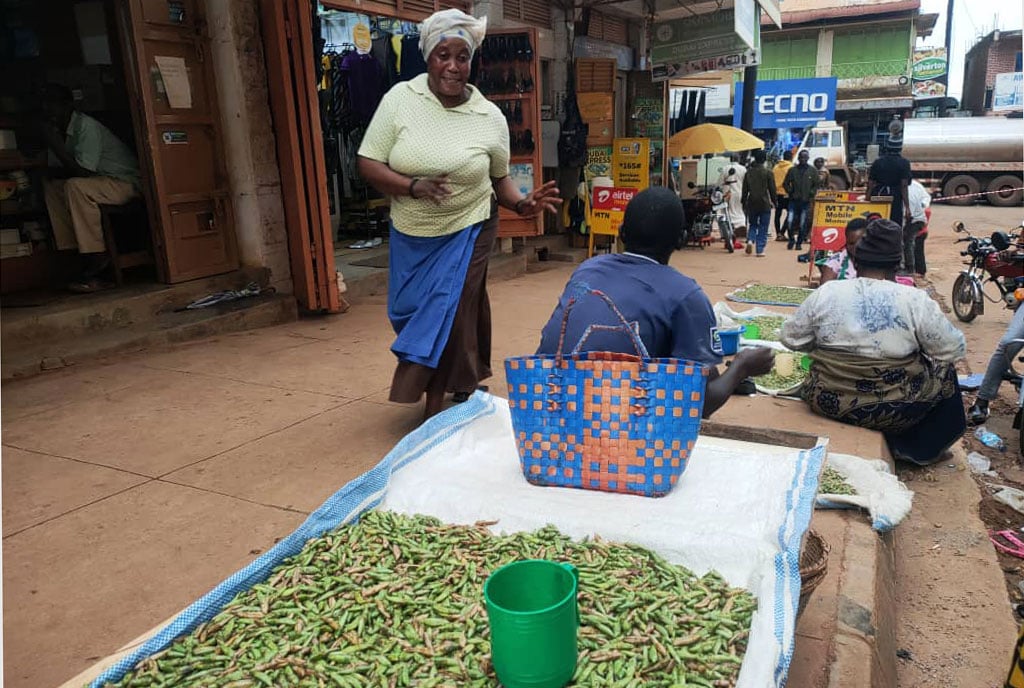Traders eye money as grasshoppers return just on time

Vendors selling grasshoppers in Masaka City on November 25, 2023. PHOTO | RICHARD KYANJO
What you need to know:
- Nyendo in Masaka City is a beehive of activity as traders prepare the delicacy for customers.
Grasshoppers, locally known as nsenene, are here again.
The nsenene usually appear around late October through November and part of early December. However, last year they delayed, which created anxiety among trappers and traders who always make a killing from selling the delicious insects.
Entomologists blamed this scenario on the changing weather patterns and wanton depletion of their breeding grounds such as wetlands and forests. But this year, grasshopper dealers started selling the traditional delicacy last week in many markets around Masaka and Kampala cities.
“This time the insects look big, which could be a result of the rain we are currently experiencing in our area,” Mr Henry Sembatya, who deals in this seasonal business at Busega Market in Kampala, said.
ALSO READ: Mystery of missing nsenene revealed
Nyendo, a traditional hub of grasshoppers in Masaka City, is currently a beehive of activity as traders prepare the delicacy for customers. A cup of sorted grasshoppers costs Shs10,000.
Mr Quraish Katongole, the chairperson of Old Masaka Basenene Limited, an umbrella of grasshopper trappers in the country, says they made the right prediction about the appearance of the insects when they set their traps as early as October 25.
“Unlike last year when the country experienced long dry spells, this time round most parts of the country have been receiving sufficient rain, which we believed to attract grasshoppers,” he said
However, the trappers have raised concerns over the cost of materials they use in catching the insects.
Mr Saka Kaweesi, a trapper in Kyazanga Town Council, Lwengo District, said the prices of the mercury bulbs they use in trapping grasshoppers are too high.
“A bulb of 400 watts, which is good for this work, costs Shs120,000; this is too high and I need at least four bulbs to harvest enough grasshoppers,” he said.
“But it’s disappointing that some of these bulbs start blowing out two days after being installed due to fake items on the market,” he added.
Ms Mariam Namutebi, another grasshopper dealer, raised concern over the persistent power blackouts, which, she said, are partly affecting their business.
“Due to heavy rains, some electric poles fall and they take a long time to be replaced, which affects our catch. We have to improvise by using generators, which are costly due to the high cost of fuel,” she added.
In Kabale, some grasshopper dealers said although this grasshopper season started early compared to that of last year, the insects still come in small quantities. He echoed sentiments about electricity load shedding.
Grasshopper dealers in Kabale Town, including Mr Geoffrey Bakare and Mr Gidion Areeba, also complained of fake electric bulbs that malfunction after lighting for a short period.
“A cup of sorted and cleaned grasshoppers is currently at Shs5,000 while that of the unsorted ones is at Shs1,000. We are hopeful that the quantity will improve because the season has just started,” Ms Budesi Musigwa, one of the grasshopper dealers in Kabale Town, said.
In Kisoro District, Ms Harimah Mutezi, a grasshopper dealer, said she has already set up a simple grasshopper trapping site at a cost of Shs3m and hopes to make some good money because of the early arrival of the grasshoppers.
“Encouragingly, some grasshoppers that I trapped last weekend were large and oily. Currently, I sell a bag of grasshoppers weighing 100kg at Shs150,000 because I am aware of the decreasing prices as the grasshopper harvest increases,” she said
Ms Allen Nyiramaliza, a grasshopper vendor on Kisoro Hospital Street, said they are currently selling a cup of sorted grasshoppers at Shs5,000 and the customer turn-up is extremely good.
However, in the West Nile city of Arua, some grasshopper dealers are discouraged from installing lights for trapping the insects because of the losses made last year. One such is Mr Joseph Ondoga, who said: “Last year, I spent about Shs400,000 to put up the lights but in the end, I didn't even get a cup. I am taking a break this year.”
Mr Ondoga said he used to make money from this business, which helped him to pay fees for the first term. Asked whether he will not miss making money from the grasshoppers, he said: “I will miss the money but I am not sure it will be much this year also. I will only buy them for home consumption from those who have trapped them.”
Last week, a few of the grasshoppers were sold, coming mainly from Alangi Town in Zombo District. As the trend is, the grasshoppers in West Nile are expected to full scale from mid-November to early December.
Ms Jennifer Apio, a resident of Awindiri Cell in Arua City, said: “In the early 1990s, grasshoppers used to come in plenty and for a long time, but these days the season lasts for a few weeks. I think people must have tempered with their breeding grounds.”
The market for nsenene is largely found in Uganda’s urban centres though many people in other countries are also developing an appetite for this seasonal delicacy. Grasshoppers are highly nutritious with proteins, fats, carbohydrates, ash, and dietary fibre.
*Compiled by Al-Mahdi Ssenkabirwa, Robert Muhereza, Malik F Jjingo, Julius Hafasha, Felix Warom Okello & Clement Aluma




